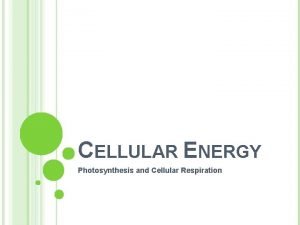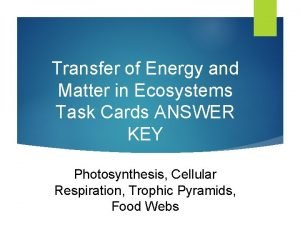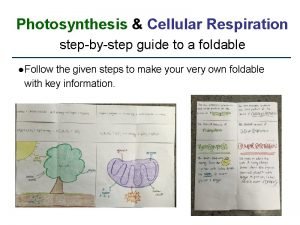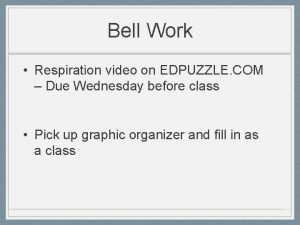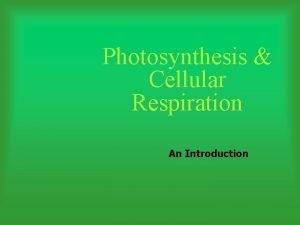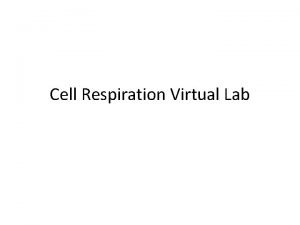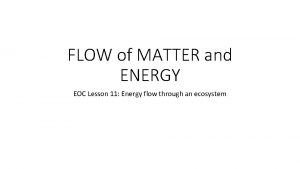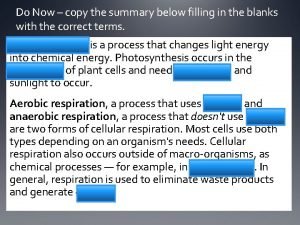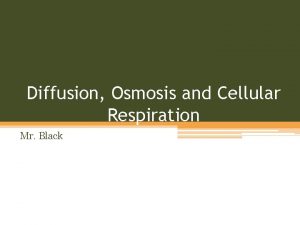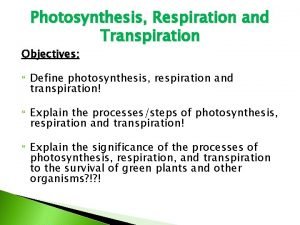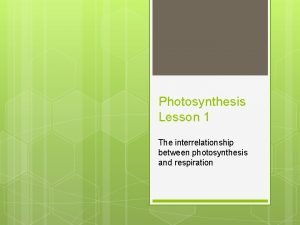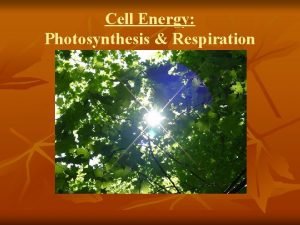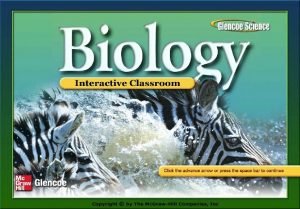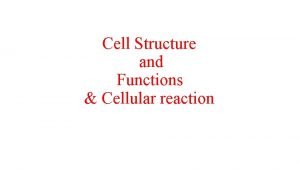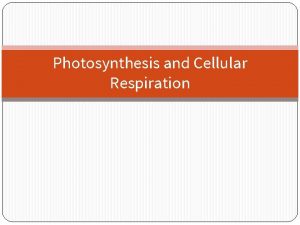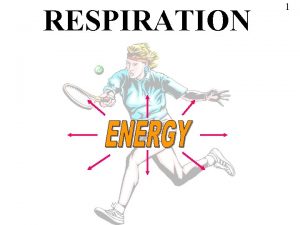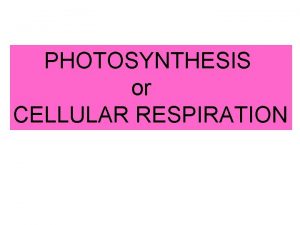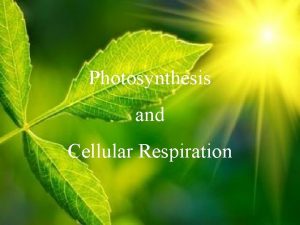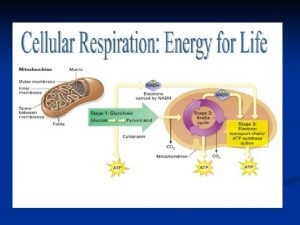Photosynthesis and Cellular Respiration CH 7 Cellular Respiration





















- Slides: 21

Photosynthesis and Cellular Respiration CH 7: Cellular Respiration pg 131 Section 3

Photosynthesis and Cellular Respiration Section 3 Cellular Respiration • All living organisms go through cellular respiration. – Series of chemical reactions to make ATP from glucose Equation for Photosynthesis • 6 CO 2 + 6 H 2 O + pigment + sunlight C 6 H 12 O 6 + 6 O 2 Equation for Cellular Respiration • C 6 H 12 O 6 + O 2 6 CO 2 + 6 H 2 O + ENERGY (ATP)

Photosynthesis and Cellular Respiration Section 3 • There are 2 scenarios – Aerobic (with oxygen) – Anaerobic (without oxygen) • Anaerobic – Glycolysis (only method for some prokaryotes) • Occurs in cytoplasm • Fermentation allows for this process to keep going • 2 ATPs are made

Photosynthesis and Cellular Respiration Aerobic Respiration • Occurs in the mitochondria • Kreb’s cycle • Electron Transport Chain Section 3

Photosynthesis and Cellular Respiration Section 3 Glycolysis • Series of chemical reactions that take place in the cytoplasm and does not need oxygen to work. • In glycolysis, enzymes break down one of glucose into two pyruvate/pyruvic acid molecules. *Glue glycolysis illustration into notes

Photosynthesis and Cellular Respiration Glycolysis Section 3

Photosynthesis and Cellular Respiration Section 3 Glycolysis, pg 133 • Step 1, Breaking Down Glucose – Glucose is converted back into 2 - G 3 P (3 carbon molecule).

Photosynthesis and Cellular Respiration Section 3 Glycolysis • Step 2 and Step 3, NADH and Pyruvate – Each of the G 3 P go through a series of chemical reactions • Converted into Pyruvate (pyruvic acid) – 2 molecules NADH are created • Important because NADH are Hydrogen ion/proton and ecarriers

Photosynthesis and Cellular Respiration Section 3 Glycolysis produces 2 ATP • with O 2 it also produces 2 NADH, 2 Pyruvates

Photosynthesis and Cellular Respiration Section 3 Fermentation (anaerobic process) pg 134 • To make ATP during glycolysis, NAD+ is converted to NADH. – Organisms must recycle NAD+ to continue making ATP through glycolysis. • The process in which carbohydrates are broken down in the absence of oxygen is called fermentation. – Beneficial because it allows glycolysis to continue supplying a cell with ATP in anaerobic conditions.

Photosynthesis and Cellular Respiration Pathway Lactic Acid Fermentation Section 3 Reaction PYRUVIC ACID + NADH LACTIC ACID + NAD+ *occurs in muscle cells for short term energy production, also used in the production of foods ex. yogurt, Kim chi, sauerkraut Alcoholic Fermentation PYRUVIC ACID + NADH ALCOHOL+ CO 2 + NAD+ *occurs in yeast cells and is used in the production of beer, wine and bread

Photosynthesis and Cellular Respiration Two Types of Fermentation Section 3

Photosynthesis and Cellular Respiration illustration Section 3

Photosynthesis and Cellular Respiration Section 3 Aerobic Respiration • 1 st stage is the Krebs cycle – a series of reactions that produce electron carriers • (NADH and FADH 2) • 2 nd stage electron transport chain takes place in the inner membranes of mitochondria – ATP synthase are located here • Up to 36 ATP molecules can be produced from one glucose molecule in aerobic respiration.

Photosynthesis and Cellular Respiration Section 3 Kreb’s Cycle • Pyruvate (from glycolysis) is broken down and combined with other carbon compounds creating Co. A. – Releasing CO 2 – 2 ATP, 6 NADH, and 2 FADH 2

Photosynthesis and Cellular Respiration Section 3

Photosynthesis and Cellular Respiration Section 3 Electron Transport Chain • Takes place in the inner membranes of mitochondria – ATP synthase are located here • NADH and FADH 2 from the Krebs cycle – transfer energy in the form of e- and H+ into the electron transport chain. • e- are used to pump the H+ across the membrane to create a concentration gradient

Photosynthesis and Cellular Respiration Section 3 Electron Transport Chain ATP Production • Hydrogen ions diffuse through ATP synthase, providing energy to produce several ATP molecules from ADP.

Photosynthesis and Cellular Respiration Section 3

Photosynthesis and Cellular Respiration Section 3 The Role of Oxygen • At the end of ETC – the e- combines with an oxygen atom and two hydrogen ions to form two water molecules. • If oxygen is not present, – the electron transport chain stops, because hydrogen has no where to go. – the electron carriers are not recycled, so the Krebs cycle also stops

Photosynthesis and Cellular Respiration Section 3 Summary Cellular Respiration Reactants Products Location Gycolysis Glucose, 2 ATP 2 Pyruvates, 2 NADH, 4 (2) ATP Cytoplasm Krebs Cycle 2 Acetyl. Co. A (Co. A) CO 2, 6 NADH, Matrix of 2 FADH 2 , 2 ATP Mitochondria ETC 6 NADH, 2 FADH 2, O 2 34 ATP, H 2 O, 6 NAD, 2 FAD Inner Mitochondrial Membrane
 The process of photosynthesis and cellular respiration
The process of photosynthesis and cellular respiration Equation of cellular respiration
Equation of cellular respiration Complementary processes
Complementary processes Formula for photosynthesis and cellular respiration
Formula for photosynthesis and cellular respiration Photosynthesis and cellular respiration diagram
Photosynthesis and cellular respiration diagram Photosynthesis and cellular respiration foldable
Photosynthesis and cellular respiration foldable Edpuzzle
Edpuzzle The chemical process of photosynthesis
The chemical process of photosynthesis Photosynthesis and cellular respiration virtual lab
Photosynthesis and cellular respiration virtual lab Photosynthesis and cellular respiration jeopardy
Photosynthesis and cellular respiration jeopardy Photosynthesis or cellular respiration
Photosynthesis or cellular respiration Venn diagram photosynthesis and respiration
Venn diagram photosynthesis and respiration The warm up osmosis
The warm up osmosis Define photosynthesis
Define photosynthesis Interrelationship between photosynthesis and respiration
Interrelationship between photosynthesis and respiration Chapter 6 cell energy photosynthesis and respiration
Chapter 6 cell energy photosynthesis and respiration The mimosa plant displays thigmotropism
The mimosa plant displays thigmotropism Chapter 8 section 2 photosynthesis
Chapter 8 section 2 photosynthesis Photosynthesis vs. respiration
Photosynthesis vs. respiration Redox reaction in cellular respiration
Redox reaction in cellular respiration What is the correct equation for cellular respiration?
What is the correct equation for cellular respiration? Chemiosmosis steps
Chemiosmosis steps



